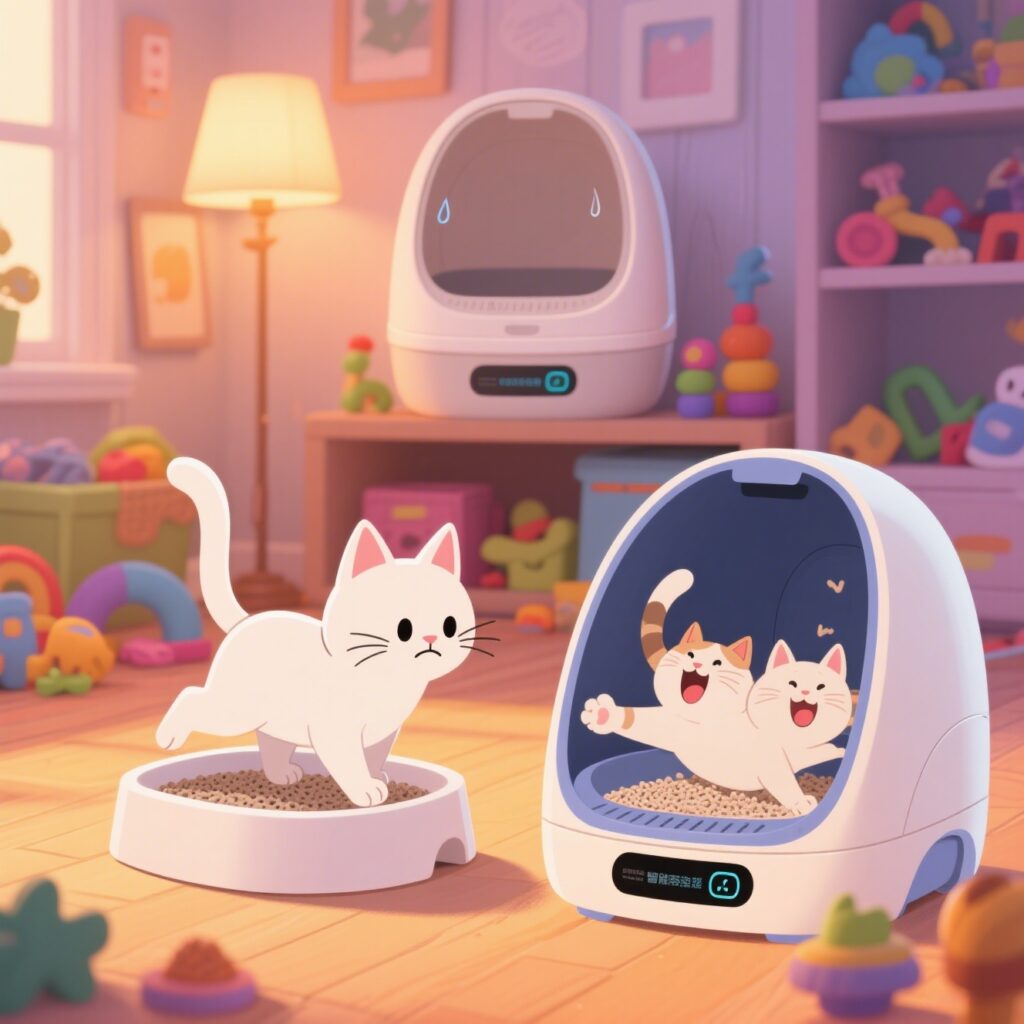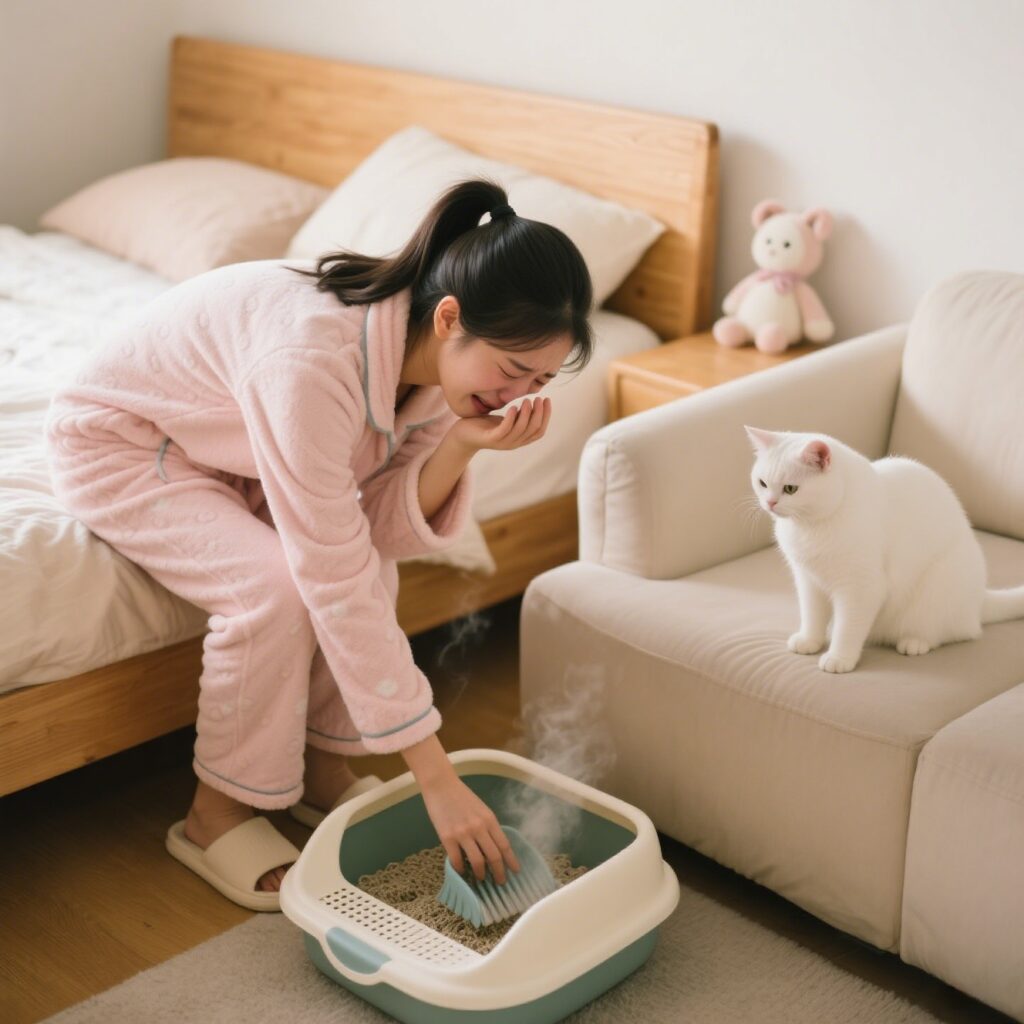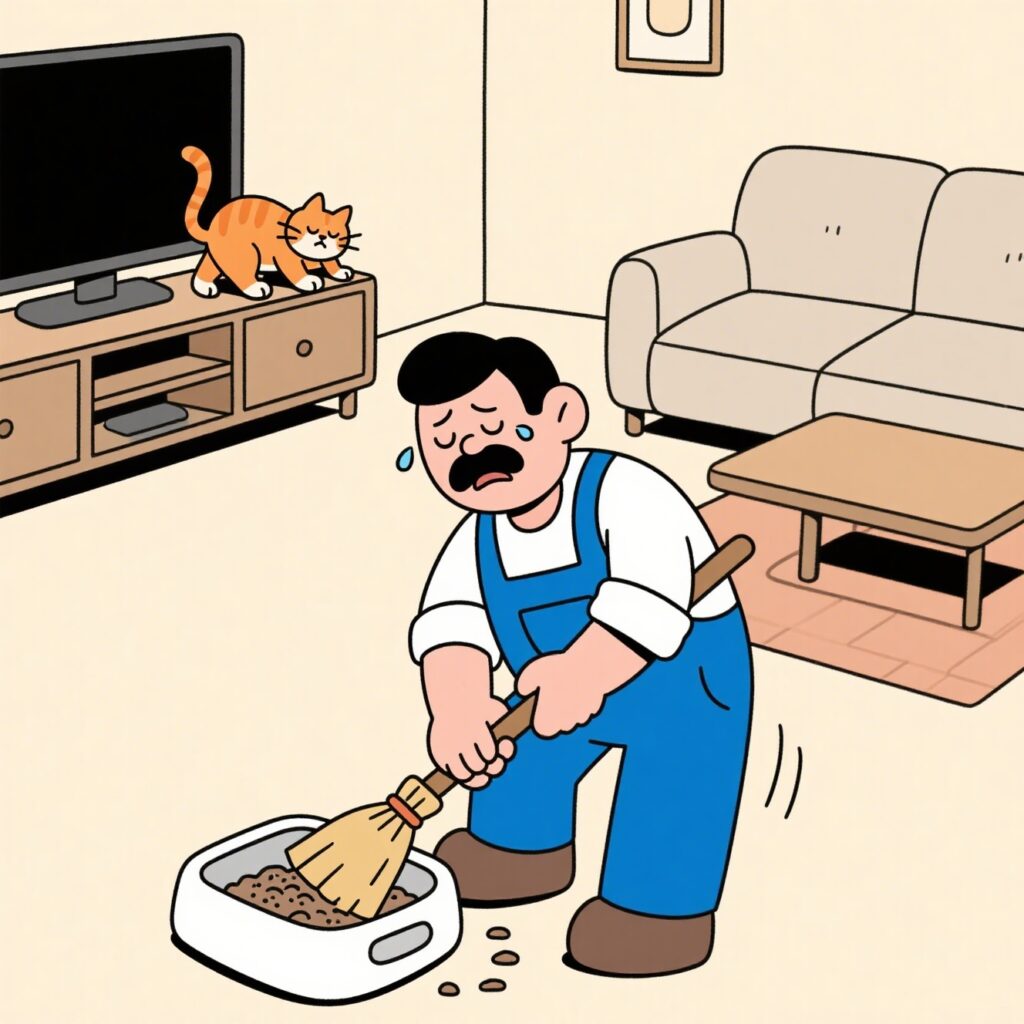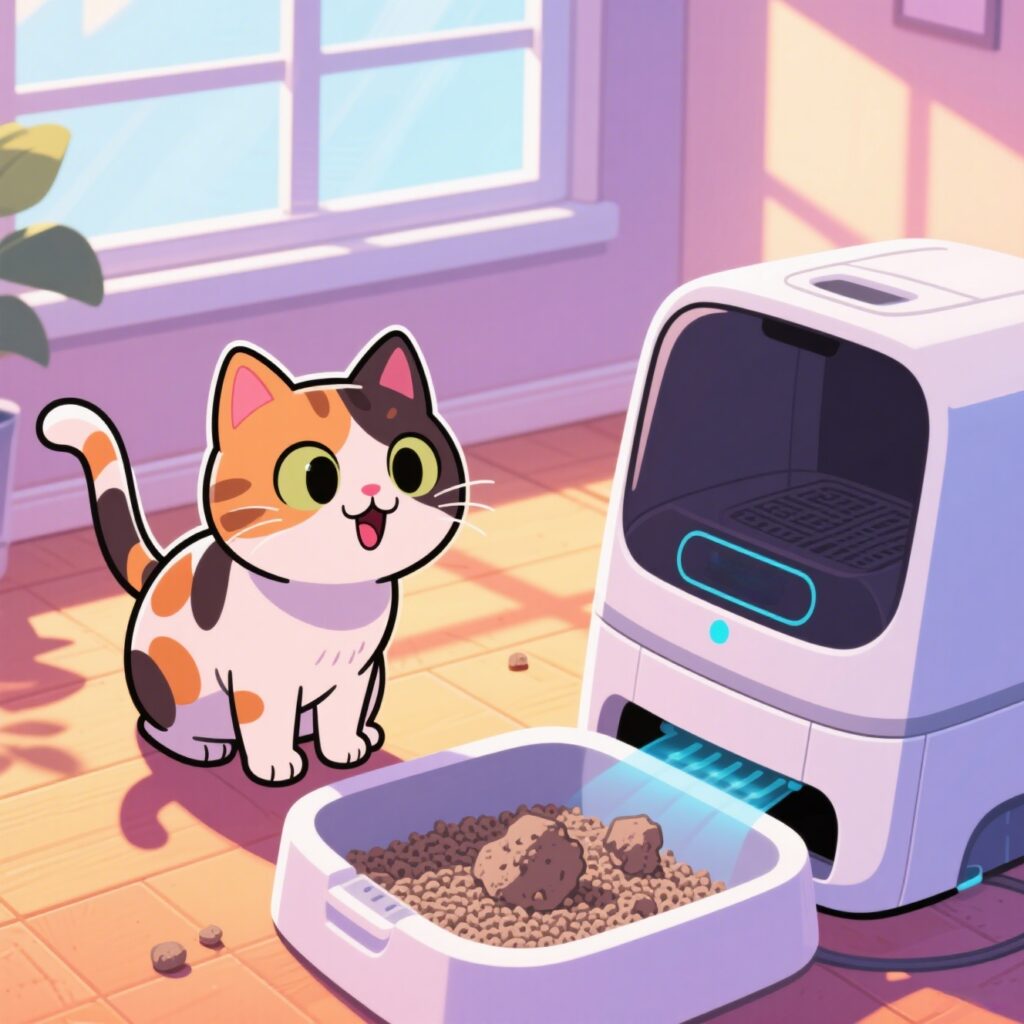Introduction
Welcome to the world of self-cleaning litter boxes, where technology meets pet care to enhance your furry friend’s health and happiness! Keeping a cat’s litter box clean is crucial for their health, as a dirty litter box can lead to various health issues, including infections and respiratory problems. The good news? Self-cleaning litter boxes are becoming increasingly popular among pet owners who are eager to maintain top-notch hygiene with minimal effort. In this blog, we’ll explore how these innovative litter boxes not only make life easier for pet owners but also contribute significantly to the well-being of our feline friends. Get ready to discover the myriad of benefits that self-cleaning litter boxes bring to both cats and their humans!
Understanding Self-Cleaning Litter Boxes

What are self-cleaning litter boxes and how do they work
Self-cleaning litter boxes are a modern twist on the traditional litter box that aim to make life easier for both pets and their owners. These innovative devices are designed to automatically sift, rake, or even flush waste away, eliminating the need for daily scooping. But how exactly do they work, you might ask? Well, self-cleaning litter boxes typically employ a combination of sensors, motors, and clever engineering. When your feline friend finishes their business and leaves the box, a sensor triggers the cleaning cycle. The unit then removes waste either by sweeping it into a compartment or by using a mechanism to dispose of it, ensuring that the box remains fresh and clean for your cat’s next visit. It’s like having a robot butler, but for kitty litter!
Different types: rake-based, rotating drum, conveyor belt, and flushable systems
Self-cleaning litter boxes come in several intriguing types, each with its unique method of disposing of waste:
– Rake-based systems: These are perhaps the most common. They feature a rake that glides through the litter at regular intervals or after every use. The rake captures clumps and sweeps them into a waste compartment, effectively keeping the litter fresh.
– Rotating drum systems: Imagine a gentle spin cycle for your cat’s waste! These models rotate the drum to separate waste from clean litter. The clean litter falls back into the box, while the waste is deposited into a container.
– Conveyor belt systems: These models use a conveyor belt to carry waste to a collection bin. It’s like a mini waste-traveling escalator that ensures only clean litter remains behind.
– Flushable systems: For those yearning for a more environmentally friendly option, some self-cleaning litter boxes can be connected to your plumbing. They flush waste away directly, much like a toilet, minimizing odor and mess.
Key features: automatic waste removal, odor control, and ease of maintenance
Self-cleaning litter boxes boast several key features aimed at making pet care a breeze:
– Automatic waste removal: The crème de la crème of self-cleaning litter boxes is their ability to clear waste automatically. It’s a time-saver and ensures that your cat always has a pristine place to go.
– Odor control: Let’s face it; litter boxes can get stinky without regular cleaning. Many self-cleaning systems have built-in odor control features, such as carbon filters or sealed waste compartments, to keep unpleasant smells in check.
– Ease of maintenance: Say goodbye to the days of frequent scooping. Self-cleaning boxes require much less attention. You’ll simply need to clean the waste bin periodically and perform general maintenance to keep things running smoothly, allowing more time for cuddles and playtime.
Hygiene Benefits for Cats
Reduction of bacteria and pathogens in the litter box environment
Cats are fastidious creatures that cherish cleanliness, and rightly so. A clean litter box goes beyond just appeasing your feline’s neat nature—it is crucial for their health. Traditional manual scooping may not always be consistent, leading to a buildup of bacteria and pathogens. Self-cleaning litter boxes mitigate this risk by ensuring the box is swiftly cleaned after each use, thus significantly reducing the bacterial population and the chances of pathogen-related health issues. In short, these boxes offer a hygienic environment that matches your cat’s high standards.
Prevention of urinary tract infections and other health issues linked to dirty litter

Regular maintenance of a clean litter environment is vital in preventing certain feline health issues, such as urinary tract infections (UTIs). When waste accumulates in a litter box, it can become a breeding ground for bacteria known to cause UTIs and other infections. Self-cleaning litter boxes help prevent these concerns by ensuring waste is promptly removed. This regular removal keeps the litter clean and reduces the presence of harmful bacteria, helping to keep your whiskered friend healthy and happy.
How timely waste removal reduces ammonia buildup and respiratory risks
A dirty litter box doesn’t just pose the threat of infections; it can also lead to respiratory issues for your furry pal. As waste sits in a box, ammonia levels can rise, potentially causing respiratory problems for both cats and people sharing the space. Timely waste removal is crucial in reducing ammonia buildup. Since self-cleaning litter boxes systematically remove waste soon after your cat uses the box, ammonia levels are kept low, contributing to a healthier breathing environment. Breathing easy is a win-win for everyone in the home, especially for your cat!
Behavioral Benefits and Stress Reduction
Cats’ Natural Preference for Clean Litter Boxes
Cats are known for their fastidious nature, and one of their most prominent instincts is the need for cleanliness. In the wild, cats bury their waste to hide their scent from predators, and this behavior naturally carries over to our domestic companions. Therefore, it’s no surprise that they have a pronounced preference for clean litter boxes. When a litter box is dirty, cats might demonstrate their dissatisfaction by avoiding the box altogether and finding other less appropriate places for their needs.
Self-cleaning litter boxes cater to this natural preference by automatically scooping away waste shortly after it’s deposited. This means fresher litter, more often, which aligns perfectly with a cat’s inherent desire for cleanliness. There’s nothing quite like knowing your cat feels comfortable and content with their litter box situation.
How Self-Cleaning Systems Encourage Regular Use and Reduce Litter Box Avoidance
Litter box avoidance can be a significant issue, often resulting in unwanted messes outside the box. This behavior can indicate that your cat is unhappy with the condition of their litter box. By ensuring that the litter box is consistently clean, self-cleaning systems encourage regular use.
With traditional litter boxes, it may not always be feasible to scoop immediately after every visit, leading to lingering odors and mess. Self-cleaning systems eliminate this concern, as they continually refresh the litter, ensuring your cat always finds a tidy space. This frequent automatic cleaning can greatly reduce the instances of litter box avoidance because the litter environment remains welcoming and pleasant for your feline friend.
Impact on Reducing Stress and Anxiety Related to Dirty or Overcrowded Litter Boxes

Fluffy’s peace of mind is just as important as their physical health. Stress and anxiety in cats can manifest in several ways, including inappropriate elimination behaviors, heightened aggression, or a reluctance to use the litter box. A dirty or overcrowded litter box can be a major source of such stress.
Self-cleaning litter boxes address these issues by preventing the accumulation of waste and keeping the litter box area clean, which minimizes the anxiety associated with a dirty environment. This is especially beneficial in multi-cat households where the litter box can quickly become overwhelmed. By ensuring the box is constantly at an optimal level of cleanliness, you can help create a more relaxed and stress-free environment for your feline companions, making them more likely to use the box regularly.
Benefits for Pet Owners

Convenience and Time-Saving Aspects of Automated Cleaning
Let’s face it, scooping a litter box isn’t anyone’s favorite chore. But with self-cleaning litter boxes, this task becomes virtually hassle-free. Automated cleaning means that you don’t have to worry about constantly checking the litter box or scrambling to clean it at the end of a long day. This convenience is perfect for busy pet parents who want more time to focus on cuddles rather than cleaning.
Owning a self-cleaning litter box can save significant time each week, allowing you the freedom to spend more quality time with your pet and less time managing their bathroom habits. With the automatic removal of waste, you can enjoy a cleaner, more organized home environment with less manual involvement.
Improved Home Hygiene and Reduced Unpleasant Odors
Imagine walking into your home after a long day at work to a clean, fresh-smelling home. One of the main benefits of self-cleaning litter boxes is their impressive odor control capabilities. Traditional litter boxes can quickly become sources of unpleasant smells if not cleaned frequently. In contrast, self-cleaning litter boxes frequently scoop waste into a separate compartment, effectively controlling odors and keeping your home smelling fresh.
By keeping the litter box cleaner for longer, these systems not only improve hygiene around the house but also enhance the overall pleasantness of your home environment. You and your guests will appreciate the absence of lingering pet odors, making social gatherings more enjoyable and stress-free.
Encouragement of Consistent Litter Box Maintenance Routines
Consistency is key when it comes to maintaining a clean living space for your cat. Self-cleaning litter boxes help promote this regularity by automating the cleaning process, ensuring that the litter box is always performing at its best. Many pet owners find that with a self-cleaning litter box, they’re naturally encouraged to perform regular checks and maintenance, such as refilling litter and occasionally wiping down the unit to keep everything in tip-top shape.
As a result, having a self-cleaning litter box not only helps in keeping your home clean and smelling fresh but also supports the establishment of consistent routines that benefit both you and your pet. Integrating these routines can lead to a healthier, happier life for your furry friend, while providing peace of mind for you as a pet owner.
Health Monitoring Features in Advanced Models
One of the remarkable advancements in self-cleaning litter boxes is the introduction of health monitoring features. These enhanced models are not just about convenience—they’re smart little helpers that can give pet owners peace of mind by keeping an eye on their furry friends’ health.
Some Self-Cleaning Litter Boxes Include Sensors to Track Usage Patterns
Ever wondered how frequently or infrequently your cat uses the litter box? Some modern self-cleaning litter boxes come equipped with sensors that track your cat’s usage patterns. These sensors can record how often your feline visits the box, providing patterns over time. This data can be invaluable in understanding what’s typical for your pet, and it’s all tracked automatically without requiring any extra effort on your part.
Early Detection of Changes in Litter Box Habits Signaling Potential Health Problems
These smart sensors do more than just count visits—they help alert pet owners to unusual changes that might indicate a health issue. For example, increased visits to the litter box or a sudden decrease in use could signal problems like urinary tract infections or digestive issues. Early detection of these changes is crucial, and having a litter box that can alert you allows for quicker intervention and treatment, possibly preventing a minor issue from becoming a major health concern.
Integration with Apps for Alerts and Health Insights
In keeping with the digital age, many of these advanced litter boxes offer integration with smartphone apps. Through these apps, you can receive real-time alerts about your cat’s habits and any notable deviations. These handy apps also provide health insights based on the data collected, helping you stay informed about your cat’s well-being even when you’re not at home. Such connectivity transforms a simple litter box into a key component of pet health monitoring, making it easier to ensure that all is well with your beloved cat.
Considerations When Choosing a Self-Cleaning Litter Box

Choosing the right self-cleaning litter box isn’t a one-size-fits-all endeavor. Several factors should guide your decision, ensuring that the litter box you choose is perfect for both your household and your furry friend.
Size and Design Suitable for Different Cat Breeds and Household Needs
First off, size and design are crucial. Cats come in all shapes and sizes, from petite to positively plump. That means your litter box should accommodate your cat comfortably—larger breeds will need more room to maneuver. Additionally, consider your household’s space and where the litter box will fit best. Some designs are sleek and compact, ideal for a cozy apartment, while others might be bulkier but offer more features. Assessing both your cat’s needs and your household space will lead to a more harmonious choice.
Noise Levels and How They Affect Pet Comfort
As you know, cats can be sensitive creatures, especially to unfamiliar noises. When choosing a self-cleaning litter box, it’s wise to consider the noise levels during the cleaning process. Some designs are quieter than others, ensuring your kitty isn’t startled or stressed by loud mechanical sounds. If your cat is particularly skittish, a quieter model might be the way to go to preserve their comfort and encourage regular use.
Maintenance Requirements and Costs (e.g., Replacement Trays, Power Consumption)
Finally, don’t overlook the maintenance aspect. Even though these litter boxes are automated, they still require some level of upkeep. Think about how often you’ll need to replace trays or cartridges, and whether they use electricity or batteries—both of which can affect running costs. Consider how easy it is to clean and maintain, as some models might have hidden costs in power consumption or accessory replacements. All these factors are vital to ensure that the convenience of an automated system doesn’t come with unforeseen expenses.
In summary, the new tech-savvy self-cleaning litter boxes not only make life easier for cat owners but also contribute significantly to pet health. By selecting the right model that fits your and your cat’s specific needs, you can enjoy the best balance of technology and pet care, leading to a happier home.
Potential Limitations and Solutions
While self-cleaning litter boxes are undeniably a revolutionary tool in maintaining your furry friend’s hygiene and health, it’s important to address some of the potential limitations they pose and explore practical solutions.
Initial Cost and Affordability Concerns
Let’s face it: self-cleaning litter boxes can be a bit pricey upfront. The technology and automation built into these devices contribute to their higher cost compared to traditional litter boxes. However, before dismissing them as an unnecessary luxury, consider the long-term benefits they offer.
– Long-term Savings: By minimizing the time spent on cleaning and maintaining litter boxes, pet owners can save both time and money in the long run. Plus, these high-tech boxes can reduce the need for frequent veterinary visits due to hygiene-related health issues.
– Cost-Benefit Analysis: Weighing the initial investment against ongoing convenience and health benefits can make the decision clearer. Look for sales or payment plans that can make these devices more accessible.
Not Suitable for All Cats
While many cats will quickly adapt to the automated nature of self-cleaning litter boxes, they aren’t a perfect match for every feline friend, especially those with special needs.
– Elderly Cats: Older cats may be hesitant to use a quickly changing environment that is different from what they are accustomed to. A self-cleaning box’s automatic mechanisms might startle them.
– Special Needs Pets: Cats with disabilities or specific health conditions may also face challenges with navigating these automated systems.
Solutions:
– Trial Runs: Before making a complete switch, consider a trial period with a borrowed or rented unit. This allows you to gauge your cat’s comfort level without the full commitment.
– Gradual Introduction: Introduce the self-cleaning litter box alongside their regular one, allowing your pet to naturally gravitate towards the new option over time.
Tips for Successful Introduction and Acclimation
Transitioning your cat to a self-cleaning litter box can be smooth and stress-free with the right approach.
– Familiarization: Allow your cat to explore the new litter box while it’s turned off—this will help them get familiar with its structure without any unexpected movements.
– Positive Reinforcement: Encourage and reward your cat with treats or affection when they use the self-cleaning box. Positive associations can make all the difference.
– Patience: Be patient and give your cat time to adjust. Some cats may take days or weeks, but with consistent encouragement, they will likely adapt.
Future Trends in Self-Cleaning Litter Technology

With the rapid advancement of technology, the future of self-cleaning litter boxes is poised to become even more exciting and beneficial for both pets and their owners.
AI and Smart Home Integration for Enhanced Health Monitoring
Imagine a world where your cat’s litter box communicates directly with your smartphone to provide health insights.
– Smart Integration: Newer models of self-cleaning litter boxes are beginning to incorporate AI and smart technology. These advanced systems can monitor your cat’s usage and send alerts if anything seems out of the ordinary, like changes in frequency or habits.
– Health Tracking: By integrating with smart home systems, litter boxes can become part of a broader pet health monitoring ecosystem, offering insights that contribute to early detection of potential health issues.
Eco-Friendly Materials and Waste Disposal Innovations
Sustainable living is a hot topic, and the pet industry is also making strides in this area.
– Eco-Friendly Design: Future models of litter boxes are focusing on using recycled or biodegradable materials, ensuring that pet care doesn’t come at the expense of the planet.
– Innovative Disposal: Look forward to unique waste disposal systems that minimize environmental impact, such as compostable liners and efficient waste processing mechanisms.
Customizable Cleaning Schedules and Litter Types
One of the beauty of technology lies in its customizability, and self-cleaning litter boxes are no exception.
– Adjustable Schedules: Future advancements may enable personalized cleaning cycles that suit your cat’s habits and preferences, making them even more comfortable with the technology.
– Litter Variety: The flexibility in utilizing different types of litter is becoming a reality. This allows pet owners to pick the best options for their cat’s needs, including sustainable and allergen-free choices.
In summary, while there are some hurdles to leap over when it comes to adopting self-cleaning litter boxes, the potential benefits are immense. With ongoing technological developments, these fantastic tools can become even more aligned with our lifestyles and environmental considerations. Isn’t it exciting to imagine what the future holds for both our cats and us with these smart systems in place?
Conclusion
Self-cleaning litter boxes are a game-changer for both pets and their owners. They ensure cleaner environments that dramatically reduce the risk of bacterial infections and other health problems in our feline friends. By keeping the litter box tidy, these innovative systems not only make your cat happier but also less anxious, since they don’t have to deal with unpleasant odors or mess.
For pet owners, the convenience these boxes offer is truly unmatched. With less manual cleaning, you’ll have more time to enjoy with your adorable cat. Plus, advanced features like health monitoring can help you keep a close eye on your pet’s well-being, alerting you to any potential health issues early on.
While it’s important to consider the costs and whether it’s the right fit for your specific cat, the benefits often outweigh these factors. Choosing a self-cleaning litter box isn’t just about convenience—it’s a step towards ensuring a healthier, happier life for your pet. So, why not integrate a bit of tech-savvy comfort into your pet care routine? It’s a win-win for you and your beloved feline!
Let’s develop what Astute Inno’s most advanced smart self-cleaning cat litter box can do!







